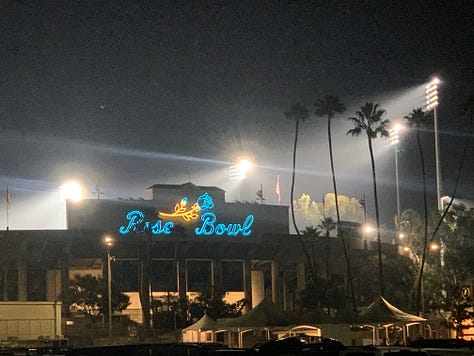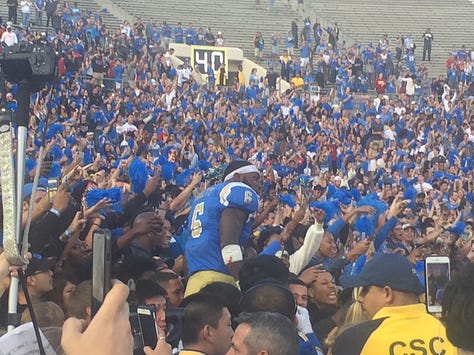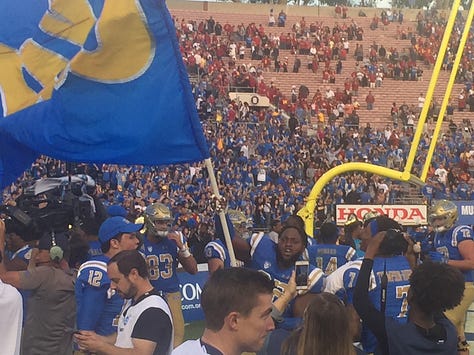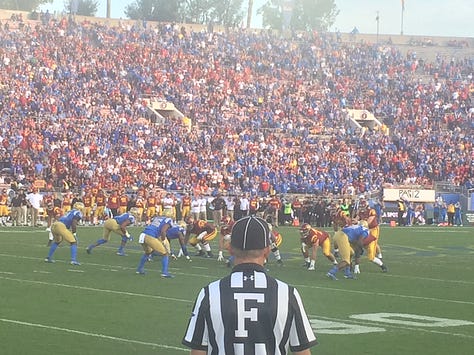Two-Team Town: A History of College Football in Los Angeles
Maybe it’s the San Gabriel Mountain backdrop against which the Rose Bowl sits, or the iconic Hollywood sign and skyscrapers of downtown Los Angeles visible from Los Angeles Memorial Coliseum.
Perhaps credit belongs to the contrast of USC’s cardinal-and-gold against UCLA’s blue-and-gold, making for what’s undeniably the most aesthetically pleasing uniform matchup in the sport. It could be the rich history cultivated since first meeting in 1929.
Whatever the reason, Los Angeles’ Crosstown Showdown appeals to the most basic, emotional connection that makes college football unique from any other sport.
This year’s installment will be my first in a decade I will not cover live — if there was ever a more damning indictment of my mush status than that, I can’t think of anything more clear than the first matchup with College Football Playoff implications ever in the series, and the first with mutual conference championship stakes in seven years happening without my presence.
Still, having covered entries into the series when one side was winning on the season and the other wasn’t; contests with head coaches on the hot seat; hell, even an empty stadium game honestly strengthens the point that UCLA-USC doesn’t need the Playoff Presented By Dr. Pepper and ESPN to be meaningful.



On the contrary: One of the most electric environments in my experiences with the rivalry came in 2018 when both the Bruins and Trojans finished below .500. UCLA’s fourth-quarter comeback in a 34-27 win snapped a three-year losing streak to USC, earned Chip Kelly his first win in the series, and cemented consummate good guy Joshua Kelley in the rivalry’s lore with a record-setting performance.
The Rose Bowl buzzed that afternoon with an energy equaling the 2014 contest, when the Bruins solidified themselves as front-runners for the South’s spot in the Pac-12 Championship Game and maintained slim but not impossible odds for UCLA to crash the inaugural Playoff1.



College football is undergoing a lot of change, very little of it good, as perhaps most aptly reflected in UCLA and USC moving to the Big Ten Conference. But their rivalry reflects the essence of the sport, and its continued survival even after the asinine, forthcoming realignment is at least one positive.
It’s also a rare win for college football in the nation’s second-largest metropolitan market.
On the same week that UCLA and USC continue a rivalry dating back to 1929, Los Angeles lost a football tradition that began 22 years prior.
Whittier College announced the discontinuation of its football program on Monday after 115 years of competition. It’s one of those news items that probably doesn’t come across the radar if you’re not in the local market, but it’s hardly insignificant.
Poets football history includes the presence of a future President of the United States on its roster — though Richard Nixon didn’t actually see the field much for Whittier. Don Coryell’s tenure as Poets head coach, however, proved transformative for the direction of offenses throughout the sport.
And while history alone isn’t sufficient to label the closure of a program a canary in the coal mine, Whittier’s is.
Let’s retrace the steps leading us to this proverbial bird cage. Some music for the occasion, if you don’t mind (and feel free to swap instances of “baseball” in the following song with “football” if it helps).
Los Angeles and, in one case each, Orange and Riverside Counties, experienced a steady decline of college football. The Southland was once a bustling metropolis for the sport, a dramatic departure from its peers among America’s Big 3, New York and Chicago.
University of Chicago was a powerhouse under Amos Alonzo Stagg. But even with Northwestern’s peaks over the last 30 years after being a laughingstock for almost a half-century, Chicagoland hasn’t had much to offer the college football world at any level.
New York’s Five Boroughs and Long Island host a variety of Div. I programs: Stony Brook in the CAA; Wagner and LIU in the NEC; Fordham in the Patriot League; Columbia in the Ivy.
Of course, all are FCS and New York has never had a top-level powerhouse to go along with the variety of smaller programs — and no, I don’t count Rutgers as New York despite the Big Ten’s marketing pitch. Even Columbia as a member of the Ivy League in its days as the premier football conference was an afterthought behind Harvard, Yale and Princeton.
Los Angeles, however, boasted its prominent flag-bearers in UCLA and especially USC. But then, football spread throughout the county for much of the mid-20th Century.
During the Great Depression and into the post-War years, programs at what are today Div. I athletic programs surfaced around Los Angeles County. Their levels of success varied, but most had at least a peak.
Loyola — before it was Loyola Marymount — peaked around the time of its demise.
The 1950 Lions broke into the AP Top 25 with a roster that included Don Klosterman. This era of football for schools that today belong to the West Coast Conference is fascinating, featuring both the ‘50 Loyola team and ‘51 San Francisco Dons that made noise on college football’s national scene.
And each program was done before former Army West Point football player Dwight Eisenhower was sworn in as President in 1953.
USF’s closure is among the more unfair and well-covered stories in college football history, a direct result of racism. Loyola’s shuttering after the 1951 campaign is more mundane, as the Lions joined a host of programs across the country in this era that ceased operations coinciding with the Korean War.
Other closures among the modern-day WCC set also weren’t as jarring as Loyola’s just one season after championship flirtations.
By the time the Pepperdine Waves crashed after the 1961 season, they endured consecutive 1-9 finishes. In 1946 and 1947, however, Pepperdine fielded teams behind coach Warren Gaer that finished 8-1 and 9-0. The former played in and won the only postseason game in program history, 38-19 over Nebraska-Wesleyan in the Will Rogers Bowl2.
In ‘47, Pepperdine’s undefeated mark included a blowout of Arizona State, 27-6, avenging the “Pepperpots”’ lone defeat of ‘46 in a 13-12 decision in Tempe.
Shoutout to the Los Angeles Times for one of the earliest instances of the still-lingering problem college football media has with confusing Arizona State and Arizona, by the way:
Gaer went to Drake following the ‘47 season, where he had continued success that culminated with the Bulldogs reaching the 1957 Sun Bowl. Pepperdine was never the same for the subsequent 15 years, and by the end endured some ugly campaigns.
The Waves were embarrassed annually in a rivalry game that doesn’t quite boast the same history or glamour of UCLA-USC. Indeed, whereas the Bruins and Trojans play for the Victory Bell, Pepperdine and Los Angeles State played for an old shoe.
At least, it was the Old Shoe Rivalry. And Los Angeles State of yesteryear became today’s Cal State LA, located in the San Gabriel Valley. The ties Cal State LA have to the city’s gridiron history are fascinating.
The LA State Diablos actually played their home games at the Rose Bowl decades before UCLA moved there. Los Angeles State also took on teams from Mexico, predating CETYS move to become the first Mexican member of the NCAA. And, until very recently, the first Heisman Trophy winner in USC history — Mike Garrett — was the university’s athletic director3.
LA State peaked in the late ‘50s and early ‘60s. By the program’s final decade of the ‘70s, it moved from the Rose Bowl to a tiny, on-campus stadium and played a schedule compromised almost entirely of Southern California schools — many of which also went defunct in the last 40 years.
In a 1-7-1 ‘75 campaign, LA State played four Los Angeles/Riverside County opponents that, as of 2022, no longer exist: Whittier, Cal State Northridge, Azusa Pacific and UC Riverside.
I chose 1975 specifically despite LA State playing two more seasons because that marked the final year of UCR football.
Now, any Angeleno will be quick to tell you that Orange, Riverside and San Bernardino Counties are decidedly not Los Angeles. And they’re correct. Depending on how snooty the neighborhood, you wouldn’t be hard-pressed to find Angelenos who dismiss the San Gabriel Valley where Cal State LA is located as belonging to the Imperial Empire, not real Los Angeles, but that’s neither her nor there.
For the sake of this exercise, we’re counting any city from which a motorist can reach downtown Los Angeles without a break in the urban sprawl as part of Southern California’s college-football legacy. UC Riverside fits that bill.
UCR was quite successful all the way up to its demise, winning eight games twice and nine once over the Highlanders’ final four seasons. Wayne Howard thrived in his two years at the helm, which included a conference championship in UCR’s 9-win 1972, before venturing elsewhere in Southern California.
Howard turned the program over to Bob Toledo, whose name you might recognize as the last head coach to win a Pac-10/12 championship and reach a Rose Bowl Game at UCLA.
Before guiding the Bruins to one of their all-time great seasons in 1998, Toledo oversaw the final years of UC Riverside football. He won 15 games in two seasons, continuing the program’s upward trajectory from Howard’s tenure, but it wasn’t enough to save the Highlanders.
From the Dec. 5, 1975 Los Angeles Times:
An unfortunate subplot to UCR’s inability to attract sufficient fans — though to be honest, 15,475 would be really damn solid for an FCS program — is that the ‘75 Highlanders roster featured enough talent to make a significant breakthrough in the years to come.
Included among that corps was linebacker Dan Bunz, an All-Rookie selection as a San Francisco 49er, who finished his college career playing for Howard at Long Beach State.
Of course, Long Beach State’s among the more well-known of the LA-area football failures, a byproduct of the 49ers surviving into the cable TV era. Long Beach State football history exists less in the abstract, extending into the 1990s and gaining some relevance at the turn of the millennium with one-time 49er (turned Georgia Bulldog) Terrell Davis breaking out as an NFL star.
The 49ers’ last season was 1991, but 1990 was the end for all intents and purposes. The university made a strong hire, bringing in George Allen after a Pro Football Hall of Fame career guiding the Rams and present-day Commanders.
And Allen’s hire paid immediate dividends. The 49ers went 6-5 in 1990 and had the foundation set to break through in the new decade to come. Long Beach State capped the season on a three-game winning streak, scoring a series of narrow victories against Cal State Northridge; rival Cal State Fullerton; and, in the season finale, UNLV.
Following the defeat of UNLV, players gave Allen a Gatorade bath. The coach died weeks later, prompting speculation that the chill from a cool, November night led to Allen’s death, but the LA Times put the kibosh on those rumors immediately. Allen’s death was the result of heart troubles.
Regardless the cause, Allen’s untimely death was a tragically fitting harbinger of Long Beach State’s demise. The shuttering of 49ers football also begin a decade-long chapter that marked the finale for Div. I football in the Southland altogether outside of the big two.
Long Beach State rival Cal State Fullerton lasted one more year before shutting down in 1992. Cal State Northridge hung on into the 21st Century as a Div. I-AA program, but with no conference affiliation and the same budgetary issues in the Cal State system that precipitated the closure of LBSU and Fullerton, the Matadors’ last season was 2001.
For 20 years since university administrators put Cal State Northridge in a body bag4, Los Angeles college football existed with relative stability: USC and UCLA consumed almost all of the oxygen in the Southland, but Azusa Pacific boasted a successful NAIA and later NCAA Div. II program and the county’s northeastern cradle of colleges continued to compete in Div. III.
In the past two years, however, Azusa Pacific ended its program, leaving Los Angeles with only two scholarship-awarding football programs. Occidental made the “painful decision” to call it quits. And then came Whittier’s announcement this week.
Azusa Pacific fell victim to Div. II conference realignment; with the end of the GNAC and its former members primarily joining the Texas-based Lone Star Conference, fielding a team didn’t make financial sense.
But the closure of Div. III programs that don’t incur the same expenses, primarily playing local games and not funding scholarships, feels more indicative of a genuine problem. Whittier hanging it after 115 years and a truly rich history between the tenure of a former POTUS and Hall of Fame coaches in both Coryell and brief Long Beach State leader George Allen strikes me as especially worrisome.
It’s a confounding issue. Unlike Chicago and New York, neither of which are exactly known as high-school football hotbeds, Los Angeles and the surrounding counties boast some of the nation’s very best prep ball. The quality of top-tier CIF Southern Section schools (Orange, Riverside and San Bernardino Counties) matches the best that Texas, Florida or Georgia have to offer.
There’s no shortage of local talent available for a Los Angeles-area university to restart football and immediately build a winner. What’s more, as easy as it is (and sometimes, as warranted as it is) to crack jokes about lack of interest in football around Southern California, the undeniable energy that emanates from the annual UCLA-USC game suggests people will turn out if they have reason.
And yet, there’s no reason to think LA will ever be anything more than a two-team college football town.
Both the narrow window for a Playoff invitation and a spot in the Pac-12 title game evaporated just six days later when UCLA lost to Stanford, part of the Bruins’ decade of frustration against the Cardinal and the unofficial coming-out party for Christian McCaffrey. Although Stanford spoiled UCLA’s other aspirations, the Nov. 22 win over USC to make it three straight in the rivalry was a decided high point of Jim Mora’s tenure.
Credit Los Angeles’ college football scene, limited as it is, for keeping at least one tradition alive: A bowl game bearing the name of a popular entertainer.
Garrett’s tenure as Cal State LA athletic director was disastrous, resulting in the school having to pay a nearly $3 million settlement due to sexual harassment allegations levied against the former USC star. Considering Garrett’s tenure as USC AD in the 2000s was an undeniably major contributing factor to the Trojans decline in the 2010 — Garrett’s defiance toward NCAA investigators was cited as part of the governing body’s decision to hammer USC with sanctions in the Reggie Bush investigation — it’s fair to say the 1965 Heisman winner is the worst administrator in LA college sports history. Sorry Bruins fans, that means he was worse than “Chianti Dan” Guerrero.
Look, if I’m going to reference the campus on which Karate Kid’s All-Valley Tournament was filmed, I have to give it a nod. Bill Simmons doesn’t own a copyright on Karate Kid content.





